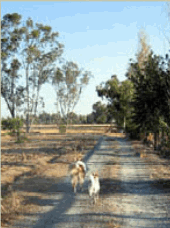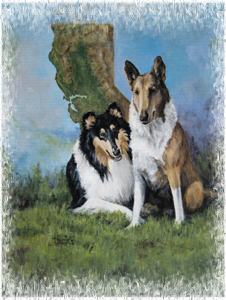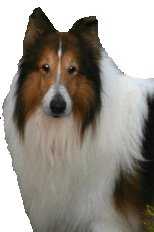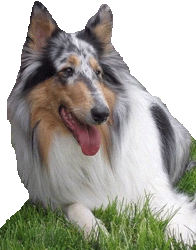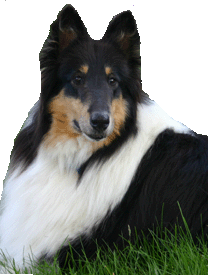|
| NorCal Collie Rescue Spring NewsletterMay 2025 |
| | | | Editor’s Note: Puppies!As the days grow longer and the flowers begin to bloom, there’s no better time to share some sunshine in the form of feel-good stories and exciting updates from our Collie community!
In this Spring edition of the NCR Newsletter, we’re thrilled to feature a special set of Happy Tails — the success stories of the litter of Collie puppies and their mama who recently found their forever homes through
NCR! Their joyful tales will brighten your day and remind us all why we do what we do.
We’re also shining a well-deserved spotlight on some of our incredible volunteers and announcing some exciting book launches! And of course, Blue is back with Blue's Reviews, his tail-wagging take on dog-friendly adventures in Northern California.
Be sure to check out those details in this issue!
~ Linda Ephraim |
|
|
|
|
|
|
|
|
|
|
| | BOARD OF DIRECTORS Karen Cavallo, President Wendy Graves, Vice President Andrea Moss, Treasurer Lisa McKenna, Secretary Linda Renaud, Director
AREA COORDINATORS Wendy Graves - Amador, Placer, Sacramento, and El Dorado Counties Karen Cavallo - Moduc, Siskiyou, Lassen, and Shasta Counties Karen Cavallo - Contra Costa, Solano, and Yolo Counties Tracey Fleming - Sonoma, Napa, Mendocino, and Lake Counties Linda Wilson - Monterey, San Benito, and San Luis Obispo Counties Vivian Stiassny - San Mateo County Sonia Villalta - San Francisco and Marin Counties Lisa McKenna - Santa Clara and Santa Cruz Counties Lisa McKenna - Central Valley and Alameda County |
| |
Thank You to the Caudills!
We’d like to take a moment in this issue of the newsletter to express our heartfelt gratitude to Lauren and Dirk Caudill. As many of you know, Lauren served as President of NorCal Collie Rescue from 2014 to 2022, and even after stepping down from that role, she has remained a dedicated supporter in countless ways. Lauren and her husband Dirk generously host Collie Fun Days, provide financial support to NCR, foster incoming Collies, help them find loving forever homes, and offer invaluable guidance to our volunteers. Their kindness, dedication, and generosity have been instrumental in shaping our organization. We simply wouldn’t be who we are today without them, and we are honored to recognize and celebrate their incredible contributions! |
|
| |
|
|
|
|
|
|
|
|
| | | Happy Tails: Myra and her Pups! By Andrea Moss The day after Christmas, Linda Renaud received an email from a woman who said her elderly parents could no longer take care of their three adult Collies (ages 3, 7.5 and 9 years), and three newborn Collie puppies. The puppies were born on 12-20-24, so they were only a week old – yikes! Linda went out to meet with the owners so we could gather more information on the situation to present to our group. I agreed to help look for foster homes and my search started immediately. But where would we find someone with the expertise to handle a nursing mother and her three puppies?
Enter longtime Collie and Sheltie rescue volunteer, Donna Shade, who also happens to be a veterinarian! She and her partner Liz agreed to take the mama and puppies on January 7. By that time, the owners d
ecided to keep the other two adult Collies but still wanted to relinquish Myra and her puppies. Linda and our wonderful past President, Lauren Caudill, decided to meet up with the owners to handle the NCR paperwork and transport mama and pups to Donna in Monterey. We cannot thank Donna and Liz enough for their tremendous 24/7 efforts in raising three wonderful Collie puppies.
And a sincere thank you to seasoned NCR adopters, Hal and Mary Jo, for stepping up without hesitation to “foster-to-adopt Myra” when the puppies were weaned. It was a huge team effort, but we found fantastic homes for all three puppies, who were adopted on Valentines’ weekend at 8 weeks. Keep reading below for their Happy Tails stories … |
| | | Happy Tails - Willow! From Willow’s new forever family: “We never thought we would see a collie puppy in rescue. And, then came Willow with her brother and sister. She is our fifth collie from this wonderful rescue. Our pack of two collies and one golden have been great with her although there are times when she is crazy that they give me that ‘what were you thinking!’ look. I am so proud of them. My grand-daughters adore her and ‘torture’ her on a daily basis. Looking forward to more memories with our wonderful pack.” |
|
|
|
|
|
|
|
|
|
|
| | | Happy Tails - Izzy! From Izzy’s new forever family: “My son has been asking for another Collie for 2 years. As much as we had wanted to add another dog to our home, but with transitioning to new jobs and new schools, it just wasn’t the right time, until now. When I saw that NorCal Collie Rescue had 3 puppies available Valentine’s weekend, we jumped on it - but kept it as a surprise for our son’s 11th birthday. He decided to name his dog Isaac, Izzy for short. They have been inseparable. Izzy is now 3 months old, and has been nicknamed ‘land piranha’ and ‘porch pirate,’ as he loves to grab onto our senior Collie’s mane to engage her in play - and his love for stealing socks. His big ‘sister’ and Izzy are bonding and love playing together. Izzy especially loves playing catch. He’s even made friends with our grumpy cat. He is such a precious addition to our home!” |
|
| |
|
|
|
|
|
|
|
|
| | | | Happy Tails - Lua! From Lua’s new forever family: “For as long as I can remember, I’ve always dreamed of having a Collie. Their gentle nature, striking beauty, and intelligence always captivated me. They are so elegant and regal! However, I’ve also been a strong believer in adopting and rescuing dogs, knowing that countless animals in shelters and rescues need loving homes. That’s when I discovered NorCal Collie Rescue, and it felt like the perfect solution, merging my love for the breed and my passion for helping animals in need.
When I first learned about the rescue, I was overjoyed. I placed my name on the waitlist, eager to find the right dog. I had anticipated adopting a young adult collie, perhaps one or two years old. But to my surprise, a litter of puppies became available for adoption, which was an unexpected but delightful twist. It was a golden opportunity to raise a collie from a young age, giving me the chance to shape her early experiences and ensure a strong bond. Enter Lua, my playful and energetic little girl. She has been such a joy to watch grow and evolve in the month since I brought her home. Initially, she was a shy, reserved pup, unsure of her new surroundings. But over time, her personality has blossomed into a boisterous and sassy little bundle of energy. Lua is always up for a game with her toys, and she adores meeting new people, be it adults or children. Her social nature has made her a hit with everyone she meets, and it’s been a joy to watch her confidence grow each day.
As an RVT at a veterinary hospital, I’ve had the privilege of bringing Lua to work with me. She has become quite the office mascot, interacting with my coworkers and the employee dogs at the clinic, soaking up all the love and attention she can. I’ve been dreaming of finding a hiking buddy, and Lua fits the bill perfectly. I can already envision us on outdoor adventures together, and maybe one day, she’ll even take part in herding trials. I feel so lucky to have found her through NorCal Collie Rescue, and I’m excited for all the memories we’ll create together in the future.” |
|
|
|
|
|
|
|
|
|
|
| |
| | Happy Tails — Myra! “Wow! Willow, Izzy, and Lua are incredibly cute. Well, what would you expect from a beautiful mother like me? I am the one who made this adoption frenzy happen. I am Myra. They were afraid to change my name – something about new tricks for a 7.5-year-old.
Everyone loves the pups, but they do not know everything that I went through to reach this point. I had this litter of pups on December 20th and then turmoil. The pups were demanding and challenging. Then we all moved from my comfortable home in Saratoga to another home in Monterey. This was strange, since I had never lived anywhere else, but I eventually settled in and was, I think, a good mom. That’s what they said anyways. That is… until the puppies’ teeth grew in and nursing them started to hurt! The pups were calling out for me, but I just couldn’t bear it and told them so. But they wouldn’t back off. I guess the puppies’ screaming and my calling back to th
em was a bit much for the household. So, in a couple of weeks, I moved again—this time to Los Altos. From that point, every time I saw a car, I thought it was off to another home. I tried to bark the cars away, and it must have worked, because they didn’t take me away again! The whole experience was a lot for me to handle, and it had me very worried. To make matters worse, this new home brought several feline furballs with it—another problem. The first two nights I barked like a watchdog, but that activity brought on too much attention, so I decided to stay quiet.
In addition to learning my way around a new home and yard, I had vet checks and a required surgery—that meant that I needed to wear an e-collar—crashing into everything in the house that was kneecap height. I was SO HAPPY when they took that thing off!
Traveling in the car, I curl up on the floor and try to have my body touching something on all sides—inside the house, I sleep under a chair—that is my safe zone and I only go outside for a few minutes at a time. They say that I am a Velcro dog.
During my final week as a ‘foster dog,’ I began acting like a ‘real’ Collie and not upsetting the household. At last, I felt like ‘me’ again and could relax. I still spend most of the time indoors, but I now follow my people, Hal and Mary Jo, all around the yard.
I guess I did okay—they recently adopted me and said that this is my forever home! When they took off the leash on Saturday morning, I dashed in each direction as fast as I could and then quickly returned.
Thanks to NorCal Collie Rescue. I hope I can see the pups as they grow up.”
~ Love and licks from Myra
|
|
|
|
|
|
|
|
|
|
|
| |
| Meet our newest Area Coordinator: Linda Wilson!
Tell us a little about yourself and what you do outside of volunteer work: I am a musician, teaching private voice and piano, a church musician, the producer of The Jingle Belles and The Uncommonne Carolers, professional Christmas carolers in SLO County, and a music director for theatre productions. I also teach private sewing lessons - I am still a contact through Cuesta College for Kids programs where I taught classes for years, although no longer teaching at Cuesta. I also love to ski!
I grew up in Corona, California, moving permanently to SLO County in 1981 where my grandparents originally came in 1936. SLO has been where our family was centered since then, even though my parents and most siblings are still in SoCal.
Tell us about your current Collie! Mac is our current adoptee from NorCal Collie Rescue. He is four years old and we have had him since September 2020. We were incredibly lucky to be chosen to adopt him at that time! He is a Tri-color and friendly to everyone he meets. All of our family dogs are rescues and they get along great. He loves to be near my students at lessons and is always happy to see visitors.
What do you love most about the breed? Collies are very loyal and connected to their
humans. I love the way my boy Mac talks to us all the time. We never have to guess what he is thinking. And I love his beautiful rough coat. I have loved Collies since I was very little - fell in love with Lassie on tv, film and books. It was a dream of mine to have one and I now will never be without a Collie in my home.
What prompted you to volunteer as an Area Coordinator?
I wanted to be helpful in our area and when
asked if I would consider it, agreed that it is a good time to step up.
What's your favorite memory of an NCR Collie you have fostered or adopted in the past?
In late 2019 we adopted Katie and Abby, two seniors. They were very sweet bonded sisters. We didn’t have them long as they both faced significant health issues. Just were happy we could give them a stable place for the remainder of their lives. <
/p>
|
| | |
New Memoir by NCR Volunteer, Julie Bond!
Long-time Collie owner, NCR volunteer, donor and certified behaviorist Julie Bond recently held a signing of her new book: K9Freud: My Life as an Animal Behaviorist.
For many years, Julie has been a friend of NCR rescue and has been incredibly generous with her time in assisting our foster homes, adopters and even some potential relinquishing owners with their Collies' behavior issues. Typically, Julie's advice has resulted in a beneficial outcome for the dog. We can't thank her enough for her dedication to our breed and to pets in general.
Did you know? She also has a terrific blog with so many helpful tips and ideas: https://juliebondanimalbehaviorist.blogspot.com
Below is a link to her book. Be sure to check it out!
For NCR friends, volunteers, and supporters who were unable to attend the book signing event, she is willing to send out personalized, signed bookplates to anyone who has bought the book and wants it signed.
|
| |
|
|
|
|
|
|
|
|
|
| |
Rugs! Practical Magic! By Deborah Cabness |
| My name is Deborah and like you all, I'm also a big Collie fancier! My husband and I have an 11 month old male rough coat Collie named Brodie. We got Brodie when he was three months old. Brodie is a very happy, goofy boy with a ton and a half of young dog energy. He is very sweet and has brought a whole lot of joy to my life since we got him.
A few months ago I injured my leg and knee pretty badly. I was not able to walk independently without crutches and was in a lot of pain. Almost overnight after my injury I was no longer able to walk Brodie. We live in a smal
l condo. We only have a patio area so there is no yard for him to run and play. Brodie was used to having long walks with me at least once a day and often times twice per day. When I was no longer able to walk Brodie, he started becoming frustrated. He had a lot of pent up energy without any way to expell it so he started acting out, urinating and pooping in our bedroom,. Around this same time Brodie started developing a fear of the floors. Our living room, hallway and dining room area flooring are wood and can be slippery for Brodie. We were having his nails trimmed regularly and shaving his paw pads and that seemed to help him a lot from slipping but all of a sudden (after my injury) Brodie became terrified of the floors. He refused to come out from the kitchen (where he sleeps). He got so scared that he would sometimes shiver and shake when we'd try to coax him to come into the living room to sit with us.
I didn't know what to do with Brodie. I could no longer exercise him properly and within a short period of time, Brodie began developing some very bad behavioral problems. I am very attached to Brodie and wanted him for many years but I waited until I retired so that I could be home with my puppy and take excellent care of him. Sadly, things fell apart pretty quickly and I wasn't giving Brodie the excellent home that he needed. It all seemed to start with his lack of exercise but shortly thereafter Brodie was turning into a fearful young dog and developing behavioral problems that he never had before. I didn't know how much longer I'd be unable to walk independently and I wasn't getting any better physically. I decided that the best thing for Brodie was to find him a new home. I did not want to let him go but I couldn't give him what he needed and it was awful watching him go from a very happy, goofy puppy to a fearful young dog. I had no idea what to do. I didn't want to give him away to people who were not familiar with the breed.
It occured to me that I should try to find out if there was a collie rescue in my area. I found Nor Cal Collie Rescue on line and I reached out to them and asked if they might know of someone who would adopt Brodie and provide him with all of the love and care he needed. The very next day Lisa from Nor Cal Collie Rescue contacted me! I couldn't believe that she called me so quickly. Lisa was so kind to me. She told me that she would do her best to help me and that she'd be in back in touch with me soon. Within just a few hours, Lisa contacted me again and asked me to contact Linda R. from Nor Cal Collie Rescue. I spoke with Linda almost immediately and Linda made an appointment with me for the following day!!!
Linda went out of her way on her day off from work and she drove to Fremont where we live, and met us at our home. Linda is such a sweet lady!!! I could tell that she knew dogs well and that she had experience with training dogs simply based upon how she responded to Brodie and how he minded her!!! As Linda and I talked, she asked me if I'd be willing to try a few new things here at home that she felt would really help our situation and that would reduce Brodie's stress with the flooring situation.
Linda showed me some pictures of hallway carpet runners as well as some well priced area rugs that I could order and have shipped to our home. She also gave me some tips and things that I could do to play with Brodie, so that he would get exercise even inside of our home and that would also keep him engaged mentally and physically, even though it wasn't in the way he was used to.
|
|
|
| I was so relieved!!! I really did not want to give away my dog. I love him and have become very attached to him but I didn't think that I'd be able to take proper care of his exercise needs for a long time.
Linda was so spot on about every single thing!!! I ordered the runners and rugs and started engaging Brodie in play while I was seated. Brodie was all in and he really loves playing fetch in the house now!!! I have named all of his toys and he has learned to fetch particular toys by their individual names!!! (Well, most of the time)!!! So I found out that Brodie's also a pretty smart dog!!! A lot smarter than we thought!!! Also, the hallway runners and area rugs resolved his fear of the floors immediately!!! He is no longer fearful of the floors at all!!! His confidence is back and he has not pooped or urinated in the house since t
hen!!! Linda provided me with some simple, inexpensive solutions to our problems with Brodie and I am able to keep my dog after all!!!
I have some big tears in my eyes as I write this today because I am so touched by the kindness and the compassion I was shown by these two wonderful women from Nor Cal Collie Rescue, Lisa and Linda R. These ladies did not know me. I am not affiliated with Nor Cal Collie Rescue and I didn't know anyone from the group. I was not referred to them by any mutual friend or acquaintance. I was literally a complete stranger who was badly in need of help and these two very sweet ladies treated me like family. I have never met anyone like them before and being in the place that I was in physically, these ladies were so exceptionally kind and compassionate to me. I was so sure that I would have had to surrender my dog for his best interest but these sweet women showed me a better way and they made themselves available to help me, even after the problems with Brodie were resolved!!! Lisa told me that she would even make time on her days off from work to drive all the way to my house to help with walking Brodie. Where do you meet people like this in the world today? I have never met anyone like these two special ladies and I really wanted to let you all know just
how much I appreciated their genuine kindness and just how much I needed both of these ladies at the time that I met them.
Brodie is back to being his happy, goofy self again and I'm so happy because I get to keep my dog!!! I'm starting physical therapy soon and once I'm up and at it again, I really hope to connect with the people of this group and to get to know you guys and to meet your dogs too!!! I especially can't wait to see Linda again and to also finally meet dear Lisa in person and thank her personally for being so kind to me. You guys treated me, just a stranger, like a beloved family member. I will never forget you. Thank you so much Lisa, Linda and to everyone at Nor Cal Collie Rescue!!! Brodie, pictured above, at 11 months old, on his favorite carpet runner!!!  |
|
|
|
|
|
|
|
|
|
| Happy Tails - Trooper!<
/span>
Some of you may remember littermates Glory, Diego, and Trooper, who came into our rescue last summer. These Collies were bred by an owner who thought she’d make money selling them at Christmas time. Until we picked them up, they’d been living in a dog-run with no names. They’d never been in a house, never walked on a leash, never been petted, and never been socialized with humans.
Upon being rescued, everything was new to the pups. They had to learn how to approach humans and not be upset by the movement and sounds of a TV, icemaker or microwave. They’d never seen a car on the street or another human walking or running towards them on the sidewalk - so all of this was a learning process too!
In just a few weeks after coming into their foster home, they learned to be less shy and to accept treats from a human hand. We found out quickly they like chicken!
Like Glory and Diego, who found amazing forever homes, we are proud to say that Trooper got his happy ending too! He has been officially adopted!
From his new family: “Trooper is doing fantastic—he’s an awesome dog and we absolutely love him. I’m so glad he’s a part of our family.” |
|
| |
|
|
|
|
|
|
|
|
| | | New Collie Book Written by NCR Volunteer, Donna ShadeOur extraordinary volunteer (and foster puppy-raiser), Donna Shade, DVM, has just published her first children's book: "Laddie the Lucky Dog," inspired by her own Smooth Collie, Laddie. This book brings the timeless message of hope, trust, and the irreplaceable connection between pets and their families. While it's a children's book, it can be enjoyed by pet-lovers of any age. You can purchase the book at bookstores and on Amazon, Apple iTunes store, or Barnes and Noble.
Donna's Laddie was one of the “Mercer 5,” brought in by NCR from a horrible hoarding and abuse case in Illinois back in 2022. From a disastrous beginning, he is now living the good life with Donna and her partner, Liz and his three canine buddies (two Shelties and a Pomeranian) in Mon
terey. |
| |
|
|
|
|
|
|
|
|
|
| | Looking for Ways to Support the Rescue? Here’s How!
Foster homes: We are always in need of foster homes! Every year, at least 50 collies needing to be rehomed come to the attention of NCR volunteers. Our ability to help these dogs is limited entirely by foster home availability. Our ideal foster home is someone who has one or two pet dogs or cats and can take in one needy dog at a time to work with and prepare for adoption. Often rescue dogs are ill or underweight and/or need to be spayed or neutered, in addition to other health problems that they may have. Dogs may need to stay in foster care for at least two weeks and often longer. A caring foster home can provide the basics that make that dog much more adoptable, and can evaluate each rescue dog to help NCR make the best possible placement so that the dog will be sent right away to its forever home. It's no exaggeration to say that fostering is the most important part of a successful rescue! Can you help us with fostering, even if it's only one dog per year?
Shelter checks and pick ups: Our area coordinators often need someone to visit the local shelters and make contact with the shelter staff. Or, they may need someone to check the shelter regularly for purebred Collies. Once a Collie comes into a shelter, the dog needs to be picked up and transported to a foster home. Or, on occasion, a relinquishing owner needs someone to come and pick up the dog from their home to be transported to a foster home. Can you visit a shelter in your county once a week or once a month? Please let us know.
Home checks: Every potential adopter must partici
pate in a home check. This NCR volunteer will look for evidence that the home is a good one for a Collie, as we require that all Collies have access to a clean, safe environment both inside the home and outside in a yard for the Collie to exercise and potty. This volunteer also has a good opportunity to explain the responsibilities and requirements for dog ownership and to educate pet owners in good stewardship of their pets.
Other activities for volunteers: Other ways to volunteer include making phone calls for area coordinators, making fliers, helping out at fundraising events and other educational events such as Adoption Days at shelters, transporting rescue dogs for various purposes, and just doing legwork for the area coordinator. Perhaps you can think other ways you can contribute to a successful rescue! |
|
|
|
|
|
|
|
|
|
|
| | | | Monetary donations. We also always welcome monetary donations! Please feel free to scan the QR code on the left to donate via PayPal. You can also send checks to:
NorCal Collie Rescue 274 Redwood Shores Pkwy. PMB #210, Redwood City, CA 94065.
Make checks payable to NorCal Collie Rescue. |
|
|
|
|
|
|
|
|
|
|
| | What’s in a Name? By Linda Renaud |
|
| |
|
|
|
|
|
|
|
|
| I love words. Finding the perfect moniker for a situation, experience, or perception feels like rubbing my internal genie lamp—it just glows. If I could choose my dream career, I’d name paint colors for a living. Who does that, and do they even realize how jealous I am? I can’t evaluate a color sample without knowing its story. A shade with the right name—one that's inspiring, imaginative, or just plain clever—can steal my heart. Words have colors, meaning, and depth in my eyes. In the world of dog rescue, names are often fluid. Foster homes frequently rename dogs that come from shelters, especially if they’ve only had a name for a week and little is known about their past. The new name might stick with them into their forever home, or it might change again for a fresh start. Within NCR, we sometimes refer to a dog as Sally/Nikki/Lady—or similar—so everyone can follow who we’re talking about, depending on when our paths crossed with that particular pup. I’ve personally avoided naming foster dogs—until Honor. I first saw her nameless photo on Veterans Day and immediately asked, "If I foster her, may I name her Honor?" The shelter put it on her paperwork, and so did the vet. For the first few days, I kept slipping—Brook and Emma rolled off my tongue first. Looking back, her blonde good looks could have made Monroe a fitting choice, too. We’ll save that one for another blonde bombshell! I
thought this article might help to inspire those giving a Collie a fresh start to think about names. Collies come in so many colors—sable and white, tricolor, blue merle, and even mostly white. Their coats can be smooth (short) or long and flowing. But a name should suit not just their look but their personality and their journey. Puppies, teenagers, and seasoned rescues all deserve names that fit. Even those who reach us too late for more than a final, compassionate rescue deserve a name of their own. Over the past couple of weeks, I’ve been jotting down potential dog names. Some, like Bonnie, are well-worn but timelessly appropriate for a bonnie dog of Scottish heritage. Others—Freedom, Liberty, Glory, Treasure, and Promise—speak to their past and the hope we have for their future. Below, I’m rolling out my compilation—no particular order, just possibilities waiting for the right dog to wear them! Diva will be first, as she was my first Collie for fourteen years. But I also love Bonnie, Freedom, Liberty, Glory, Treasure, Promise, Rambler, Judge, Banner, Kestrel, Hawk, Falcon, Aspen, Dallas, Honey, Whisper, Merlin, Wizard, Pixie, Sixpence, Penny, Rain, River, Meadow, Kipling, Discovery, Topaz, Dir, Soleil, Frenchie, Hollywood, Doon, Capri, Monroe, DaVinci, Picasso, Darwin, Money, Matisse, Damson, Royal, Regal, Elsa, Adonis, Athena, Apollo, Jupiter, Zeus, Scout, Dewards, Drambuie, Connery, Wallace, Melodie, MacGregor, Countess, Duchess, Bramble, McTavish, Rainbow, Jewel, Barley, Balmoral, Toddy, Savoy, Carlton, Ritzy, Shandy, Peaches, Scarlet, Rhett, Tara, Gable, Player, Crusoe, Caruso, Roley, Rover, Journey, Luna, Dreamer, Bond, Phoenix, Steinbeck, Twain, Forrest, Robbie, Diamond, Trooper, Dior, Fendi, Pilgrim, Hawthorne, Legend, Story, Oscar, Trophy, Tribute, Lord, Mystery, Magic, Charisma, Panache, Ghillie, Harmony, Gala, Bracken, Fern, Willow, Heather, Rowan, Keeper ... |
| |
“Blue’s Reviews”
Looking for a fun day trip this spring? Blue, an NCR Collie, is here to share his dog-friendly adventures!
Paws & Pinot: Dog-Friendly Adventures in Napa Valley!
Hi there, fellow furry day trippers! Spring has sprung and it’s time for another adventure
. Here are tips on how to have a fun, dog-friendly adventure in Napa!
My humans like to start the day off with a little coffee and pastries in the dog-friendly town of Yountville. I try to get lots of sniffs in as we wait in the outdoor line for some treats at Buchon Bakery. And if your humans are looking for some heartier food before their first wine tasting, don’t miss the breakfast sandwich at Mini Model. The smell of the egg sandwich will definitely make you drool! At Paraduxx Winery, not only did the nice people let me sit outside with my humans, but they brought me a charcuterie board made just for dogs - wow! The patio and surrounding gardens are also beautiful, perfect for more sniffing or relaxing on the lawn in the shade! Another great spot is Regusci Winery. Located in the Stags Leap District, this winery welcomes leashed dogs in its outdoor areas, including the gardens and picnic spots. You may also make some new friends when you meet the winery's dogs! Of course, turning back to food, time to head to Thomas Keller’s Addendum in Yountville for a bit of lunch. The smells coming from Addendum’s backyard BBQ? Amazing. I lounged in the shade under the picnic bench while my humans devoured some fried chicken.
All views expressed are Blue’s own, and not an official endorsement by NCR
|
|
| |
|
|
|
|
|
|
|
|
| |
|
|
|
| |
|
If possible, would you consider donating a small amount more to cover PayPal's service fee?
|
